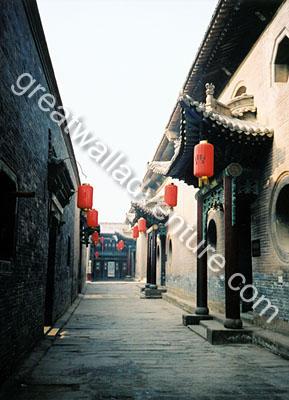|
|
Pingyao Tour of
Cao’s Compund
|
|
Historically, the businessmen of Jin (short for Shanxi
Province) have played a crucial role in Chinese commerce. They have
both contributed greatly to its development and written extensively
about their achievements. Pre-eminent among these wealthy
businessmen is the Cao's Family. The Cao's Family business, at the
height of power and splendor in the late Qing Dynasty (1644-1911),
owned more than 640 firms and 37,000 employees. It had an estimated
worth of 12 million taels of silver, the tael being a unit of
currency used in traditional China. The business had branches and
connection in Japan, Moscow, Paris and London. A visit to Cao's
Compound will give you insight into their extraordinary
achievements.
The Cao's Family first began trading in bean curd and
other commodities at the end of Ming Dynasty (1368-1644). Gradually,
the business accumulated capital, which allowed the family to erect
an estate comprised of several great houses, which became known as
the Cao's Compound. The Compound is also known as Sanduo Hall,
Sanduo meaning three mores: more good fortune, more longevity and
more children. It is located in the northern part of Beiguang
Village, 5 kilometers (about 3.1 miles) southwest of Taigu County,
and 60 kilometers (about 37.3 miles) from Taiyuan City, Shanxi
Province. With a history stretching back more than 400 years, the
Cao's Compound covers an area of 10,638 square meters (about 12,723
square yards). It is remarkable for its noble, simple and
unpretentious construction. It is built around three large
courtyards, which connect three 3-tiered, 17-meter (about 18.6
yards) high buildings that house a total of 277 rooms. These
structures are in the architectural style of Ming Dynasty, Qing
Dynasty and the Republic of China (1912-1949).
If Sanduo Hall can be called a rare flower of Chinese
residential architecture, the treasures displayed in Sanduo Hall are
its beautiful petals. Hundreds of artworks, photographs and pieces
of craft accompany paintings, calligraphies, lighting and background
music, arranged to form a beautiful image of the life of the Cao's
Family in full bloom. You can also read the history of the Cao's
Family, the lows and highs, boom and eventual bust. Their amazing
story will leave you able to view the grand courtyard and see it
almost as it was, hundreds of years ago, when its location in an
almost traffic-free tableland didn't prevent it from being a
thriving multinational headquarters for the Caos. The furniture
exhibition of pieces from the Ming and Qing Dynasties comprises more
than 400 articles, including an enormous folding screen and an
exquisite shell mirror. The screen is set with 92 pieces of precious
natural marble. 50 characters are inscribed on the back of the
screen, which form messages wishing longevity and bestowing advice
to later generations. The mirror is made of natural shells carved
with designs considered to bring good fortune. When you look at it
from different angles, the mirror appears to shine in different
colors. Interestingly, it is said that when you see the color red
you will be prosperous in your career; if you see the color pink, it
indicates that fate will join you and your lover together; while the
color of yellow promises you much wealth throughout your lifetime.
Nearly 2,000 pieces of stone ware are displayed in the porcelain
room, including bottles, pots, plates, bowls and trays, most of
which date back to the Ming and Qing Dynasty. The most amazing piece
is a national treasure from the Qing Dynasty - a golden clock shaped
like a locomotive. The clock is an article of tribute from France;
it weighs about 42.25 kilograms (about 93.14 pounds), has a
weatherglass and, after being wound up, can travel along a track.
When the combined Allied Forces invaded Beijing, Empress Dowager
Cixi escaped to Shanxi. To cover her expenses, she borrowed several
thousands taels of silver from the Cao's Family. After her return to
Beijing, she gave the family the clock as a token of her gratitude.
In the porcelain room you will also find a famous copy of an
invaluable painting - "The Upper River during the Qing Ming
Festival". It is thought that all these treasures bless the
courtyard with a double portion of good fortune.
Since being open to public visitors, The Cao's Compound
has proved very popular with tourists, due to its unique appearance
and charming style.
Tour Pingyao
with Great Wall Adventure Club, the best Pingyao
tour agent to help
you with your hotel booking and transfers.
|
|

